As acclaimed Swedish chef-restaurateur Björn Frantzén makes his debut in London, he outlines his unique Japanese-inspired philosophy, explains why French tasting menus just don’t work and charts the group’s rapid international growth
Björn Frantzén doesn’t do demonstrative. The 45-year-old Swede is matter of fact, no nonsense, even a tad serious. He is also deep in the process of becoming one of the world’s most important chef-restaurateurs.
Let’s lay out the facts, in appropriately straightforward fashion: he has not one but two restaurants ranked in The World’s 50 Best Restaurants – his eponymous Stockholm flagship in the main list at No.25 and its Singapore sibling, Zén, in the extended list at No.70. Both have been awarded three-star Michelin status – a double that is notoriously rare, especially for non-French restaurants.
Earlier this year, the group opened the sumptuous Villa Frantzén in Bangkok, garnering rave reviews for its relaxed but refined Scandinavian vibe in the midst of one of the busiest metropolises on earth. Now another contrasting and cosmopolitan capital, London, is home to Studio Frantzén, which graces a reimagined space on the fifth floor of iconic department store Harrods.
Next year will see no let-up either, with 2023 openings already confirmed in Dubai, Shanghai and Singapore, and ongoing discussions around new Frantzén franchises in Macau, Hong Kong and Kuala Lumpur. This is a man on an international mission, with the globally acclaimed talent in his ranks to back up his ambition.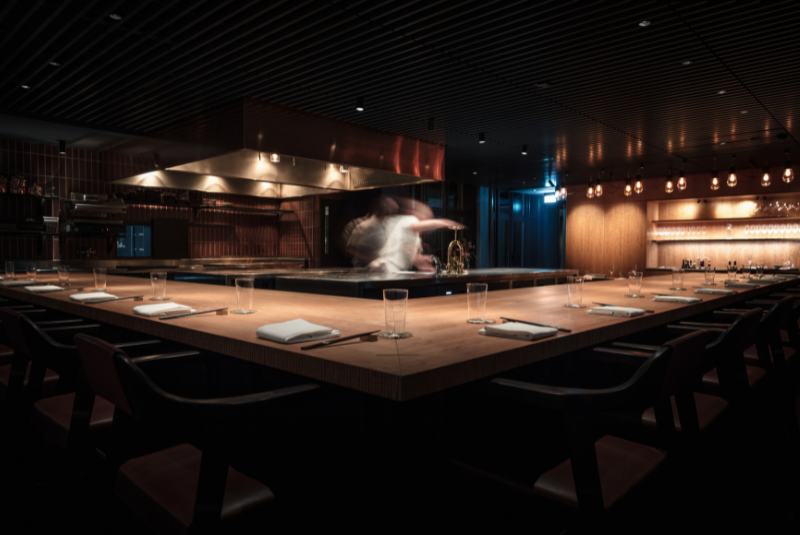
The interior of Frantzén in Stockholm, ranked No.25 on The World's 50 Best Restaurants list 2022
A gastronomic ecosystem
Beyond mere expansion, Frantzén is highly influential because his style of food is as close to unique as is possible in the ever-overlapping gastronomic sphere. To term it ‘Nordic with a heavy Japanese influence’ doesn’t quite do it justice; the chef successfully melds northern European and Asian ingredients with a kaiseki philosophy (a multi-course gastronomic approach rooted in respect and hospitality), drawing on myriad techniques gleaned from his classical French culinary training, from the traditions of his homeland and from his extensive travels.
“Almost 10 years ago I travelled throughout Japan, studying the food and the kaiseki tradition in depth,” says Frantzén. “Remember that the French only took the idea of tasting menus from Japan, but in French cooking there is so much more gluten, lactose and fat that a tasting menu is too heavy.
“Of course, with fat comes flavour, so you need to extract flavour very carefully if you are reducing the fat content. You also have to work with acidity much more, but in that way New Nordic is much closer to the Japanese tradition [than the traditional European style] with its emphasis on fermentation and preservation,” he adds.
London diners can now get a taste of this singular approach in a wide-ranging menu that cherry-picks elements from sources as varied as Scotland, Japan, France, Cambodia, Italy and Sweden – often combining two or three in a single dish. Starters include tuna and red deer tartare with vendace roe, white kombu, wasabi-infused cream, fermented plum and warm ginger butter. Mains highlights take in veal with fermented kampot pepper jus and sake-braised maitake mushrooms, or the bluntly named ‘Sweden vs Japan’, which features braised Swedish dairy-cow brisket (compressed and crisped) alongside grilled Japanese wagyu and miso mustard.
Desserts range from a take on sticky toffee pudding with miso ice cream through to lingonberry marshmallow sorbet with waffles and liquorice meringue, again reflecting the global pantry of ingredients and influences with which Frantzén works his magic. “I create every dish on every one of the menus,” he says. “I don’t want to be left in trouble if one my chefs leaves. If someone asks me about a dish, I need to know everything about it – it’s my name above the door, after all.”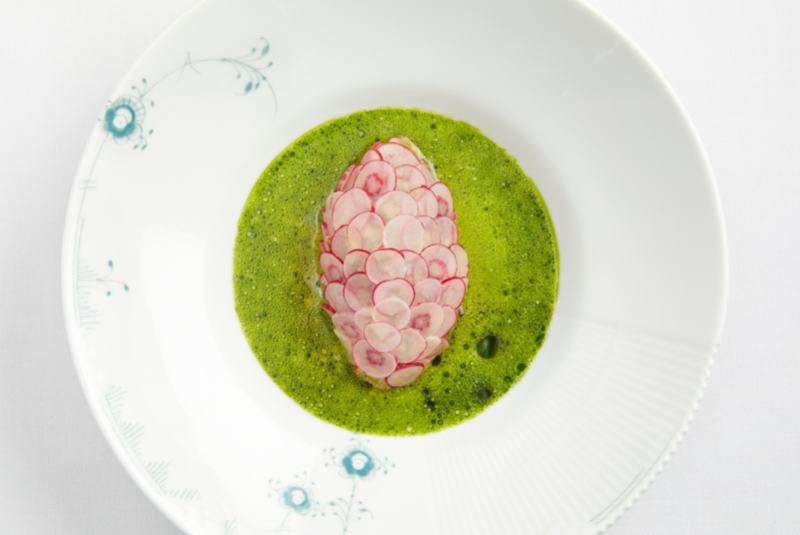
Sashimi of hiramasa truffled dashi vinaigrette, preserved Amalfi lemon, green onions and radishes
London calling (again)
Studio Frantzén, which sits atop Harrods – “In what was previously the hair and beauty salon…” deadpans the chef – is distinctively Scandinavian in style and also deceptively large. It effectively incorporates five different spaces in one: a bar-lounge space, then the main room with booth-like tables as well as counter seating along an open kitchen on one side, and a further more intimate dining area beyond. Three cute semi-circular tables overlook the restaurant from the mezzanine, which leads to the purpose-built covered terrace space complete with another bar serving Nordic-accented cocktails. In total it can seat more than 150 people, with the same à la carte offer available throughout. Tables will be held for walk-ins from Harrods’ well-heeled clientele.
The chef-turned-restaurateur spent seven formative years working in London for chefs including Gordon Ramsay and Raymond Blanc early in his career, so the Harrods opening marks a significant return. “It’s very exciting to be back here,” says Frantzén. “This has inevitably been delayed by the pandemic, but that makes it feel even better to be open. It’s the first of its kind [in the group] but others will follow.”
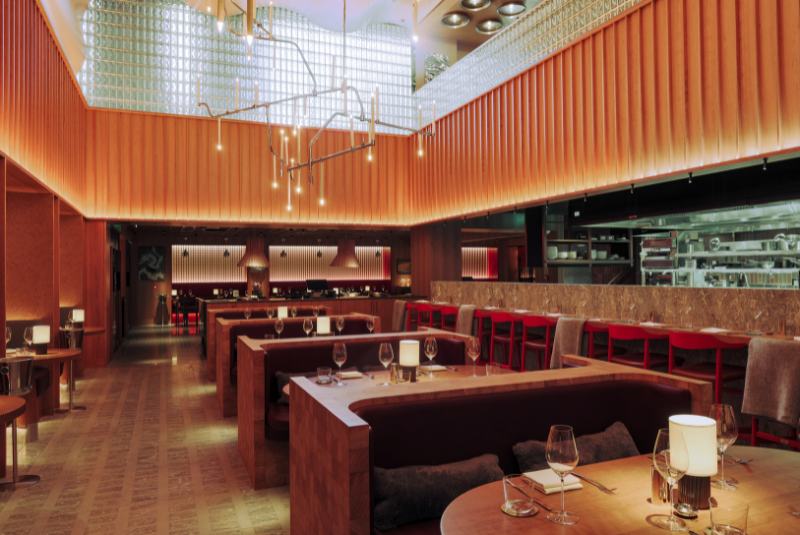
Studio Frantzén has recently opened in Harrods, London
Speaking of which, what has prompted the rapid global growth? “There are two reasons,” starts Frantzén. “Partners are offering us the chance to open in great places like this [Harrods], and investing in us, so it makes good business sense. Second, it makes sense on a human level because many of the team have stayed with us since we started more than 10 years ago; if you build a team of great people, then eventually they want to grow, to have more responsibility. It makes sense to help them do that within the group by opening new restaurants, otherwise they will leave to do their own thing. It works for them and it works for us.”
The Frantzén Group actually goes to considerable lengths to look after its people in a characteristically forward-thinking manner. The brigades at the two fine dining flagships in Stockholm and Singapore work a four-day week, with the Swedish restaurant closed on Saturdays or Sundays. “Many of the people who have stayed with us now have kids, so they deserve to have time with their family on the weekend,” adds Frantzén matter-of-factly, belying how rare this policy is in the culinary world. “We are lucky that we only have 20 seats and we are always full, so we can afford to do this.”
Whether focusing on preparing raw seafood or cooking over fire, on service details or on managing a team, Frantzén brings with him a clear-eyed focus that will continue to underpin his international ventures. Here’s a potted history of the Frantzén portfolio, city by city:
Stockholm
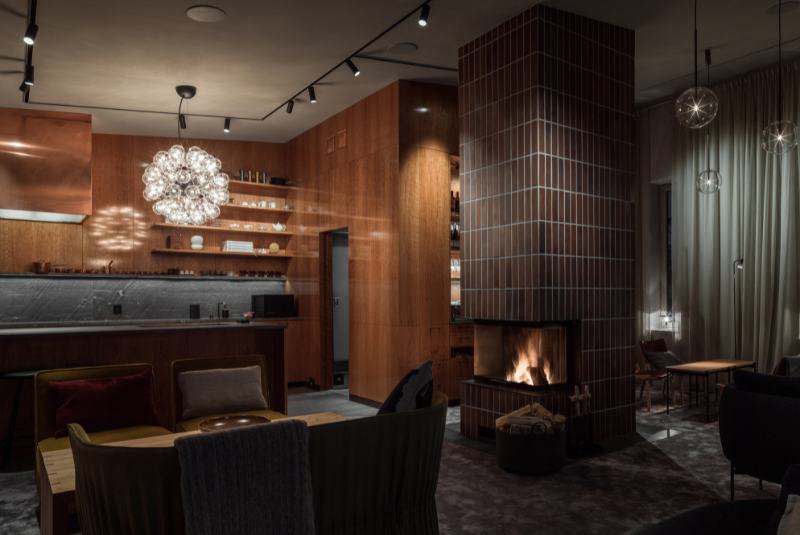
Frantzén's flagship restaurant debuted on The World's 50 Best Restaurants list in 2012
In 2008, Björn Frantzén opened his first place, Frantzén/Lindeberg, in partnership with pastry chef Daniel Lindeberg, winning the One To Watch Award at The World’s 50 Best Restaurants in 2011. The following year the pair parted ways and the restaurant was renamed simply ‘Frantzén’. It moved to its current multi-storey townhouse in 2017, with its 20 diners per sitting moving between rooms and floors over the course of their meal. The immersive tasting menu experience has seen the restaurant lauded near the top of The World’s 50 Best Restaurants in recent years. Despite travelling extensively, Stockholm remains the chef’s home and happy place. “It’s where I still love to be,” says Frantzén. “Nothing beats feeling the buzz of the restaurant in action.”
The group also runs Brasserie Astoria, located in a historic former cinema, described by Frantzén as “a big international power-dining brasserie doing 1,000 covers a day”. It’s a model that is being replicated in Singapore and potentially beyond.
Singapore

A signature dish served at Zén in Singapore: chawanmushi
Zén, located in a former shophouse, is the group’s Asian flagship. Led by talented Scottish chef Tristan Farmer, it’s a regular on the Asia’s 50 Best Restaurants list and debuted on The World’s 50 Best Restaurants extended ranking in 2022. In August 2023, it will be joined in Singapore by the second Brasserie Astoria in the city’s former Victoria Theater & Concert Hall.
Bangkok
View this post on Instagram
Chef Frantzén describes his Bangkok venture, Villa Frantzén, as the group’s “most Nordic restaurant to date”, in order to stand out in a crowded market. Opened in May 2022, its name reflects the relaxed and luxurious one-hectare space and historic residence in which the restaurant – and its stellar cocktail bar – reside. It offers a six-course set menu, but with a number of choices for each course.
Shanghai
The group’s next opening, in May 2023, promises to be the third super-premium restaurant – joining Stockholm and Singapore – in the portfolio. Unlike the aforementioned, however, it will offer an à la carte as opposed to tasting menu. As Frantzén explains, this is in part to cater to the market but partly “something a bit different and we need to keep challenging ourselves”.
Dubai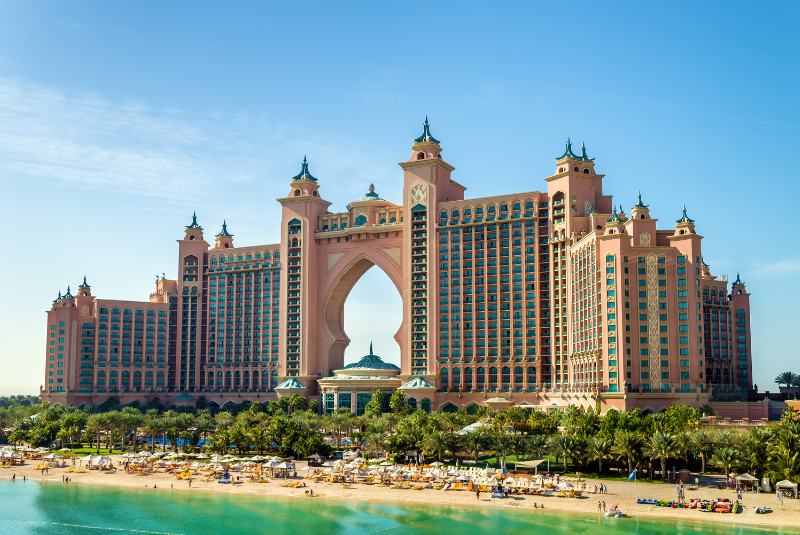
Frantzén Group marks its Middle East debut with not one but two concepts in the iconic Atlantis The Palm property, set to open in late 2023. On the ground floor (in the former Nobu premises), the second iteration of Studio Frantzén will be even bigger than the London version, housing up to 220 guests. An exclusive 20-seat restaurant will be located in a newly built rooftop space overlooking the Dubai skyline.
To stay up to date with the latest news from The World’s 50 Best Restaurants, follow us on Instagram, Facebook, Twitter and YouTube.

